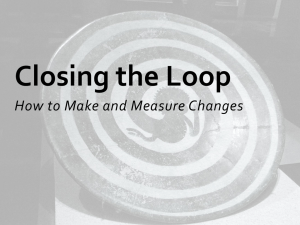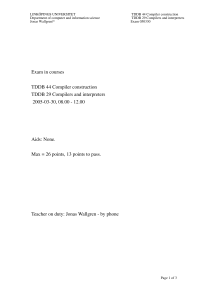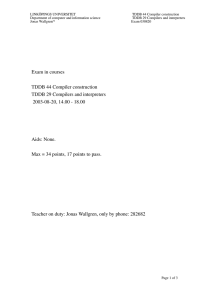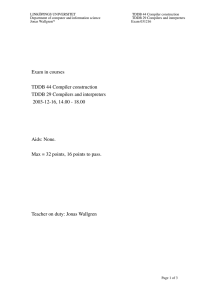LINKÖPINGS UNIVERSITET TDDA 37, TDDB 44 Compiler construction
advertisement
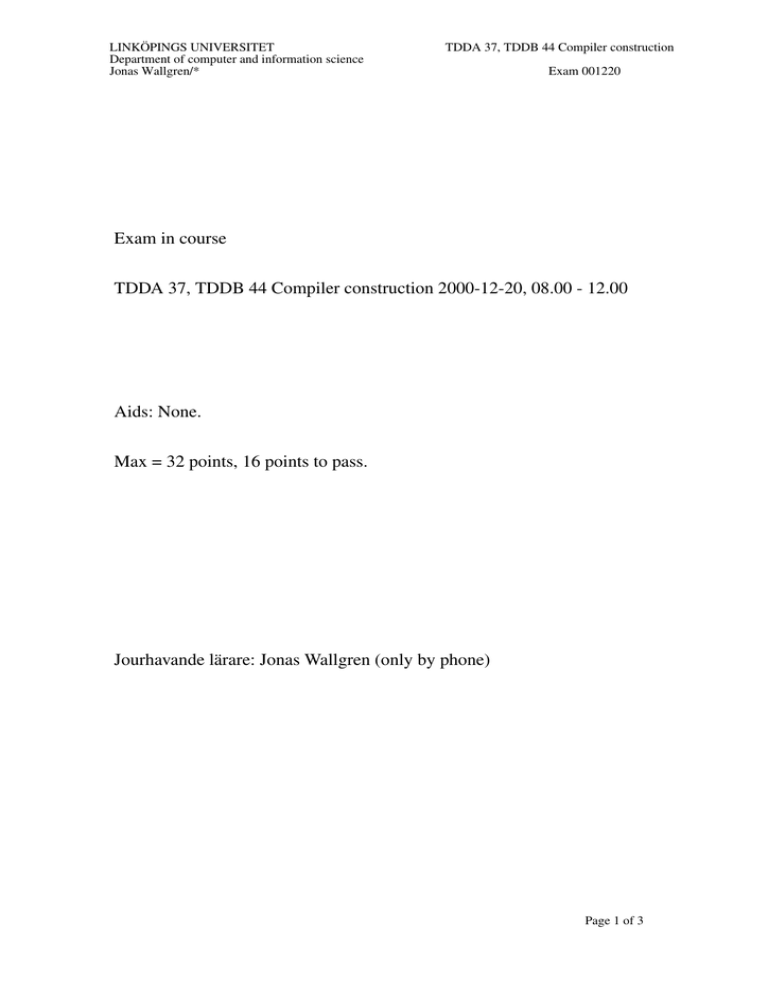
LINKÖPINGS UNIVERSITET Department of computer and information science Jonas Wallgren/* TDDA 37, TDDB 44 Compiler construction Exam 001220 Exam in course TDDA 37, TDDB 44 Compiler construction 2000-12-20, 08.00 - 12.00 Aids: None. Max = 32 points, 16 points to pass. Jourhavande lärare: Jonas Wallgren (only by phone) Page 1 of 3 LINKÖPINGS UNIVERSITET Department of computer and information science Jonas Wallgren/* TDDA 37, TDDB 44 Compiler construction Exam 001220 Problem 1 (2p) Phases and passes What is a phase and what is a pass? What phases does a compiler normally consist of? Problem 2 (2p) Symbol table Describe how a symbol table in principle, independent of how it is represented, handles a) Variable declaration, b) Variable use, c) Entrance into a block, d) Exit from a block. Problem 3 (4p) Top-down parsing Explain and remedy the problems in the grammar X::=aX|Xb|aYb|p Y::=bY|Ya|bXa|q which should be used for recursive descent parsing. Problem 4 (4p) LR parsing If the grammar X::=aX|Xb|aYb|p Y::=bY|Ya|bXa|q , where X is the start symbol, is SLR(1) or even LR(0) then show, using tables and stack, how the string abpab is parsed. If the grammar is not then show how it could be rewritten to (at least) SLR(1) (and still describe the same language). Problem 5 (5p): Intermediate code generation Translate the following code segment to quadruples, postfix code, and abstract syntax tree: while y>37 do if i>15 then x:=x+1 else y:=y-1; Problem 6 (3p) Code optimization What is a loop? Explain, using clear examples, the loop optimization methods presented in the course. Page 2 of 3 LINKÖPINGS UNIVERSITET Department of computer and information science Jonas Wallgren/* TDDA 37, TDDB 44 Compiler construction Exam 001220 Problem 7 (6p) Syntax directed translation The following grammar rule describes a for loop: <loop> ::= for <var> in <expr>..<expr> loop <stmt_list> end loop <var> takes the values between the two expressions (the endpoints included) one by one, and for each value <stmt_list> is executed. Eg: for x in 1..5 loop print(x); end loop; prints the numbers 1 to 5. a) Write a syntax directed translation scheme, using attributes and semantic rules, for the grammar rule above. The values of the both <expr>s are computed in the beginning and cannot be changed during the execution of the loop. Neither can <var> be changed inside the loop. b) What changes must be done to the solution to a) if <stmt_list> is allowed to change the loop variable and the endpoints? You don’t need to give a complete, detailed solution, just to state which parts and how, in principle. Eg (b): for x in a..b loop b:=b-1; --changes upper endpoint x:=x+1; --changes x (not the loop mechanism) end loop; Problem 8 (2p) Boot strapping On the M machine there is a compiler for the high level language S. There is an executable version and a source code version - it’s written in S itself. What is the most simple procedure to implement S on N, a machine where there is no S compiler? Problem 9 (4p) Code generation for RISC a) What is branch prediction and when is it used? Give an example! Why is it important for pipelined processors? b) Shortly explain software pipelining. Give a simple example. Page 3 of 3


